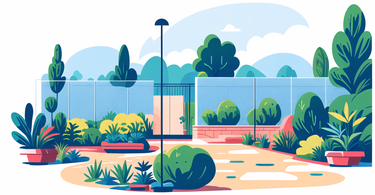Understanding the Basics of Garden Fences
Types of Garden Fences and Their Uses
Garden fences come in various types, each serving different purposes. Here are some common types:

- Wooden fences: Offer privacy and natural beauty
- Chain-link fences: Provide security at a lower cost
- Vinyl fences: Low-maintenance and durable
- Wrought iron fences: Elegant and long-lasting
- Bamboo fences: Eco-friendly and exotic look
Wooden fences are popular for their versatility and aesthetic appeal. They can be painted or stained to match your home's exterior. Chain-link fences are affordable and allow for visibility. Vinyl fences resist weathering and don't require painting. Wrought iron fences add a classic touch to gardens. Bamboo fences offer a unique, natural look.
The Importance of Fencing in Garden Design
Fencing plays a crucial role in garden design. It's not just about marking boundaries. A well-chosen fence can enhance your garden's beauty and functionality. Fences provide privacy, allowing you to enjoy your outdoor space without prying eyes. They also offer security, keeping pets and children safe within the garden.
Moreover, fences can act as windbreaks, protecting delicate plants. They can serve as support for climbing plants, adding vertical interest to your garden. The right fence can complement your home's architecture and tie the entire landscape together. It can create a backdrop for your plants, making colors pop.
Evaluating the Cost-Benefit of Garden Fences
Initial Investment vs. Long-Term Value
When considering a garden fence, it's important to weigh the initial cost against long-term value. Cheaper options like chain-link might seem attractive at first. However, they may not add much value to your property. On the other hand, a well-built wooden or wrought iron fence can increase your home's curb appeal and value.

Consider the lifespan of different materials. Vinyl and metal fences may cost more upfront but can last decades with minimal care. Wooden fences are less expensive initially but may need replacement sooner. Factor in your climate too. Some materials fare better in certain weather conditions. Think about your long-term plans for the property. A quality fence is an investment that pays off over time.
Comparing Maintenance and Durability
Different fence types require varying levels of maintenance. This affects their overall cost and durability. Here's a quick comparison:
- Wooden fences: Need regular painting or staining, prone to rot and insect damage
- Vinyl fences: Low maintenance, resist fading and weathering
- Metal fences: May rust over time, require occasional repainting
- Bamboo fences: Need regular sealing to prevent weathering
Wooden fences offer charm but demand more upkeep. You'll need to treat them every few years to prevent decay. Vinyl fences are virtually maintenance-free. They don't rot, fade, or need painting. Metal fences like wrought iron are sturdy but may rust if not properly maintained. Bamboo fences are eco-friendly but can weather quickly without proper care.
Strategies for Selecting the Right Garden Fence
Assessing Your Garden's Fencing Needs
Before choosing a fence, assess your garden's specific needs. Ask yourself these questions:

- What's the main purpose of the fence? Privacy, security, or decoration?
- Do you need to keep pets or children in (or out)?
- Are there any local regulations or HOA rules to consider?
- What's your climate like? Will the fence face harsh weather?
- How much maintenance are you willing to do?
If privacy is your main concern, solid wood or vinyl fences are good options. For security, consider taller fences with pointed tops. If you're mainly looking for decoration, wrought iron or picket fences might be ideal. In windy areas, avoid solid fences that might act like sails. Instead, opt for styles that allow some airflow.
Matching Your Fence with Your Aesthetic Preferences
Your garden fence should complement your home and landscape design. It's a key element in your property's overall look. Consider these factors:
- Your home's architectural style
- The colors and materials used in your house's exterior
- Your garden's style (formal, cottage, modern, etc.)
- The level of visibility you want between your garden and the street
For a traditional home, a classic wooden picket fence might be perfect. Modern homes often pair well with sleek metal or vinyl fences. If you have a cottage garden, a rustic split-rail fence could enhance the look. Remember, your fence doesn't have to be uniform. You can mix materials or styles for a unique look.
Consider the visual weight of different fences too. A heavy, solid fence can make a small garden feel cramped. In contrast, an airy, open design can make the space feel larger. Think about how the fence will frame your view, both from inside your garden and from the street. The right fence can create a beautiful transition between your private space and the public area.
In conclusion, choosing the right garden fence involves balancing practicality, aesthetics, and cost. By carefully considering your needs, budget, and style preferences, you can select a fence that enhances your garden for years to come. Remember, a fence is more than just a boundary - it's an integral part of your home's character and your garden's charm.
